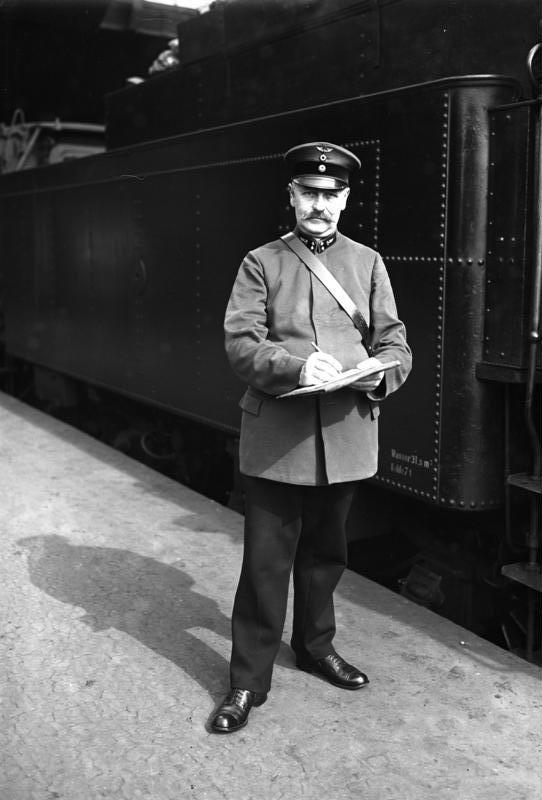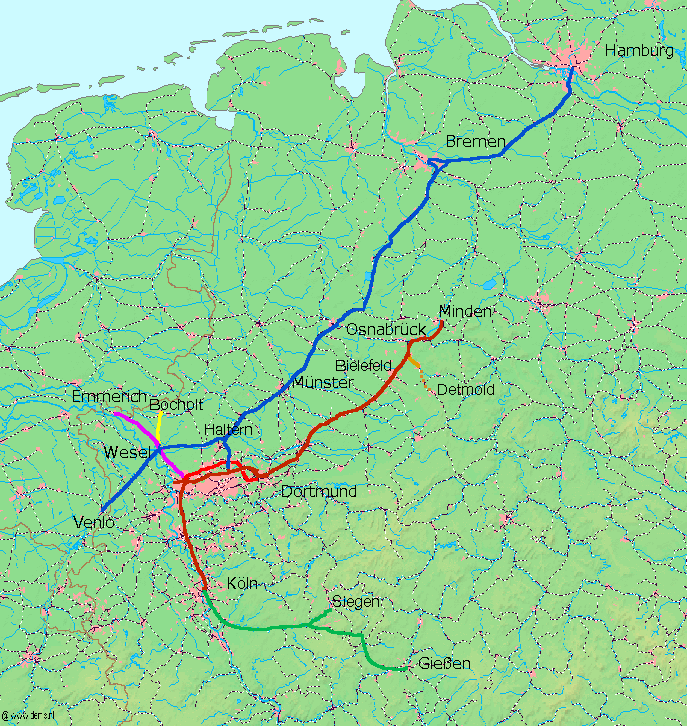|
Oberhausen Hbf
Oberhausen Hauptbahnhof is a railway station in Oberhausen, North Rhine-Westphalia, Germany. The station was opened in 1847 and is located on the Duisburg–Dortmund railway, Arnhem-Oberhausen railway, Oberhausen–Duisburg-Ruhrort railway and Oberhausen-Mülheim-Styrum railway and is served by ICE, IC, RE and RB services operated by Deutsche Bahn, Abellio Deutschland, NordWestBahn and Eurobahn. History The station was opened in 1847 as part of the trunk line of the former Cologne-Minden Railway Company. The first station building at its present location—a simple half-timbered building and loading facility—was named after the nearby Schloss Oberhausen (palace) and opened on 15 May 1847. It was the first station on the territory of the former Bürgermeisterei of Borbeck; the city of Oberhausen did not exist at this time. The station initially serviced the developing heavy industry, centred on the ''Gutehoffnungshütte'' steel works. The entrepreneur Franz Haniel had in ... [...More Info...] [...Related Items...] OR: [Wikipedia] [Google] [Baidu] |
Verkehrsverbund Rhein-Ruhr
The Verkehrsverbund Rhein-Ruhr (), abbreviated VRR, is a public transport association (Verkehrsverbund) in the German state of North Rhine-Westphalia. It covers most of the Ruhr area, as well as neighbouring parts of the Lower Rhine region, including Düsseldorf and thus large parts of the Rhine-Ruhr conurbation. It was founded on 1 January 1980, and is Europe’s largest body of such kind, covering an area of some with more than 7.8 million inhabitants, spanning as far as Dorsten in the north, Dortmund in the east, Langenfeld in the south, and Mönchengladbach and the Dutch border in the west. Structure and responsibilities The VRR is tasked with coordinating public transport in its area. This means the following: * setting and developing the fare system (“VRR-Tarif”) ** redistributing ticket revenue onto the transport companies * coordinating local train services (''Schienenpersonennahverkehr'', SPNV) within its area as public service obligations (PSO) * integrating the ... [...More Info...] [...Related Items...] OR: [Wikipedia] [Google] [Baidu] |
LVR Industrial Museum
The Rheinisches Industriemuseum (lit. Rhineland Museum of the Industry) is a decentralized museum with six locations in Rhineland, western Germany. The locations are: *Oberhausen: the main site at the old Zinkfabrik Altenberg (zinc factory), near the Oberhausen main station * Ratingen: Textilfabrik Cromford (textiles factory), the first factory in continental Europe, named after the Cromford Mill * Solingen: Gesenkschmiede Hendrichs (forge) *Bergisch Gladbach: Papiermühle Alte Dombach (paper mill) *Engelskirchen Engelskirchen (literally "angel’s churches") is a municipality in Oberbergischer Kreis, Germany in North Rhine-Westphalia, about east of Cologne. The neighbouring municipalities are (clockwise from the west) Overath, Lindlar, Gummersbach, Wie ...: Ermen & Engels cotton spinning mill * Euskirchen: Tuchfabrik Müller (textile factory) The owner of the museum is the Landschaftsverband Rheinland (LVR). See alsoLWL-Industriemuseum (formerly: Westfälisches Industr ... [...More Info...] [...Related Items...] OR: [Wikipedia] [Google] [Baidu] |
Second World War
World War II or the Second World War, often abbreviated as WWII or WW2, was a world war that lasted from 1939 to 1945. It involved the vast majority of the world's countries—including all of the great powers—forming two opposing military alliances: the Allies and the Axis powers. World War II was a total war that directly involved more than 100 million personnel from more than 30 countries. The major participants in the war threw their entire economic, industrial, and scientific capabilities behind the war effort, blurring the distinction between civilian and military resources. Aircraft played a major role in the conflict, enabling the strategic bombing of population centres and deploying the only two nuclear weapons ever used in war. World War II was by far the deadliest conflict in human history; it resulted in 70 to 85 million fatalities, mostly among civilians. Tens of millions died due to genocides (including the Holocaust), starvation, ma ... [...More Info...] [...Related Items...] OR: [Wikipedia] [Google] [Baidu] |
Railway Divisions In Germany
In Germany and Austria, the running of railway services for a railway administration or the regional network of a large railway company was devolved to railway divisions, variously known as ''Eisenbahndirektionen (ED), Bundesbahndirektionen (BD)'' or ''Reichsbahndirektionen (RBD/Rbd)''. Their organisation was determined by the railway company concerned or by the state railway and, in the German-speaking lands at least, they formed the intermediate authorities and regional management organisations within the state railway administration's hierarchy. On the formation of the Deutsche Bahn AG in 1994 the system of railway divisions (''Eisenbahndirektionen'') in Germany was discontinued and their tasks were transferred to new "business areas". Germany State railway divisions Incorporation into the state government The first railway divisions of the various German state railways (known as ''Länderbahnen''), usually reported to a specific government ministry. For example, in Prus ... [...More Info...] [...Related Items...] OR: [Wikipedia] [Google] [Baidu] |
Deutsche Reichsbahn
The ''Deutsche Reichsbahn'', also known as the German National Railway, the German State Railway, German Reich Railway, and the German Imperial Railway, was the German national railway system created after the end of World War I from the regional railways of the individual states of the German Empire. The ''Deutsche Reichsbahn'' has been described as "the largest enterprise in the capitalist world in the years between 1920 and 1932"; nevertheless its importance "arises primarily from the fact that the Reichsbahn was at the center of events in a period of great turmoil in German history". Overview The company was founded on 1 April 1920 as the ("German Imperial Railways") when the Weimar Republic, which still used the nation-state term of the previous monarchy, (German Reich, hence the usage of the in the name of the railway; the monarchical term was ), took national control of the German railways, which had previously been run by the German states. In 1924 it was reorganise ... [...More Info...] [...Related Items...] OR: [Wikipedia] [Google] [Baidu] |
Bergisch-Märkische Railway Company
The Bergisch-Markisch Railway Company (german: Bergisch-Märkische Eisenbahn-Gesellschaft, BME), also referred to as the Berg-Mark Railway Company or, more rarely, as the Bergisch-Markische Railway Company, was a German railway company that together with the Cologne-Minden Railway (''Cöln-Mindener Eisenbahn-Gesellschaft'', ''CME'') and the Rhenish Railway Company (''Rheinische Eisenbahn-Gesellschaft'', ''RhE'') was one of the three (nominally) private railway companies that in the mid-19th century built the first railways in the Ruhr and large parts of today's North Rhine-Westphalia. Its name refers to Bergisches Land and the County of Mark. History Foundation The Bergisch-Markisch Railway Company was founded on 18 October 1843 in Elberfeld (Today Wuppertal). Since the Cologne-Minden Railway Company had decided to build its route via Duisburg rather than through the valley of the Wupper river, the Bergisch-Markisch Railway Company (german: Bergisch-Märkische Eisenbahn-Gesellscha ... [...More Info...] [...Related Items...] OR: [Wikipedia] [Google] [Baidu] |
Prussia
Prussia, , Old Prussian: ''Prūsa'' or ''Prūsija'' was a German state on the southeast coast of the Baltic Sea. It formed the German Empire under Prussian rule when it united the German states in 1871. It was ''de facto'' dissolved by an emergency decree transferring powers of the Prussian government to German Chancellor Franz von Papen in 1932 and ''de jure'' by an Allied decree in 1947. For centuries, the House of Hohenzollern ruled Prussia, expanding its size with the Prussian Army. Prussia, with its capital at Königsberg and then, when it became the Kingdom of Prussia in 1701, Berlin, decisively shaped the history of Germany. In 1871, Prussian Minister-President Otto von Bismarck united most German principalities into the German Empire under his leadership, although this was considered to be a "Lesser Germany" because Austria and Switzerland were not included. In November 1918, the monarchies were abolished and the nobility lost its political power during the Ger ... [...More Info...] [...Related Items...] OR: [Wikipedia] [Google] [Baidu] |
Essen-Borbeck-Mitte
Borbeck-Mitte is the central borough of ''Borbeck'', the fourth suburban district of Essen, Germany. Together with the other boroughs of the district, it was incorporated on April 1, 1915. Borbeck-Mitte has a population of roughly 13,500 people and a total area of . The name Borbeck derives from ''Bor(a)thbeki'', which means either ''river in a fertile lowland'' or ''river of the Bructeri''. History Early history synopsis The first document mentioning Borbeck dates back to 869, when ''Borthbeki'', a small rural commune, was mentioned as one of nine communes around Essen Abbey which were liable to tax. In 1288, princess-abbess ''Berta von Arnsberg'' bought probably mortgaged parts of the region and built the predecessor of ''Schloss Borbeck''. By the 14th century, Schloss Borbeck had become the favorite residence of the princess-abbesses, which came along with a rise of prestige for the region. In 1339, princess-abbess ''Katharina von der Mark'' had Borbeck's old Romanesque ... [...More Info...] [...Related Items...] OR: [Wikipedia] [Google] [Baidu] |
Schloss Oberhausen
''Schloss'' (; pl. ''Schlösser''), formerly written ''Schloß'', is the German term for a building similar to a château, palace, or manor house. Related terms appear in several Germanic languages. In the Scandinavian languages, the cognate word ''slot''/''slott'' is normally used for what in English could be either a palace or a castle (instead of words in rarer use such as ''palats''/''palæ'', ''kastell'', or ''borg''). In Dutch, the word ''slot'' is considered to be more archaic. Nowadays, one commonly uses ''paleis'' or ''kasteel''. But in English, the term does not appear, for instance, in the United Kingdom, this type of structure would be known as a stately home or country house. Most ''Schlösser'' were built after the Middle Ages as residences for the nobility, not as true fortresses, although originally, they often were fortified. The usual German term for a true castle is ''burg'', that for a fortress is ''festung'', and — the slightly more archaic term — ''v ... [...More Info...] [...Related Items...] OR: [Wikipedia] [Google] [Baidu] |
Cologne-Minden Railway Company
The Cologne-Minden Railway Company (German, old spelling: ''Cöln-Mindener Eisenbahn-Gesellschaft'', ''CME'') was along with the Bergisch-Märkische Railway Company and the Rhenish Railway Company one of the railway companies that in the mid-19th century built the first railways in the Ruhr and large parts of today's North Rhine-Westphalia. Founding The founding of the Cologne-Minden Railway Company in 1843 in Cologne ended a long struggle for a railway line between the Rhineland and the German North Sea ports, as well as the Prussian capital of Berlin. From the 1830s several railway committees in the cities of Düsseldorf, Cologne and Aachen attempted to find a solution with each other and the Prussian government. The focus of all these efforts was to avoid the Dutch duties on trade on the Rhine, which significantly increased the cost of import and export of goods via the Rhine. Some of the Cologne committee members under David Hansemann (1790–1864)—a merchant and banker fr ... [...More Info...] [...Related Items...] OR: [Wikipedia] [Google] [Baidu] |
Cologne-Minden Trunk Line
{{unreferenced, date=January 2014 The Cologne-Minden trunk line is a railway built by the Cologne-Minden Railway Company (''Cöln-Mindener Eisenbahn-Gesellschaft'', CME). The line is the westernmost part of the railway line from Berlin to the Rhine that was proposed by Friedrich List in his Concept for a railway network in Germany, published in 1833. In fact, Friedrich Harkort (“father of the Ruhr”) had proposed the construction of a railway line from Cologne to Minden in 1825. History On 18 December 1843, the CME was awarded the concession to build a railway line between the metropolis of Cologne, the cities of the Ruhr, Rhenish-Westphalian industrial area and Minden to connect with the network of the Royal Hanoverian State Railways. A route through the Bergisches Land had been dropped was due to the high cost of the engineering structures that would have been required on the advice of the Aachen merchant and banker David Hansemann (1790-1864), who was then briefly Prussian ... [...More Info...] [...Related Items...] OR: [Wikipedia] [Google] [Baidu] |






